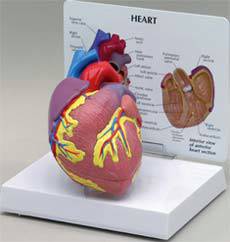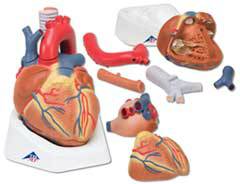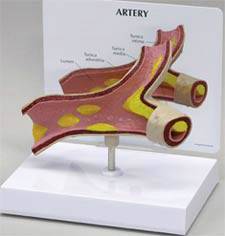Home » Hospital & Durable Medical Equipment » Using an Artery Model for Medical Consultations » Using an Artery Model for Medical Consultations
Using an Artery Model for Medical Consultations
Communication between a doctor and a patient is one of the most critical parts of the diagnosis and ongoing treatment. Many times there are miscommunications, sometimes on the part of the physician and sometimes on the part of the patient. One reason why miscommunication can occur is because the doctor is speaking in technical terms about something that the patient understands only on a basic level. Since the information coming in may not match with what the patient already knows and understands, problems can easily arise.
A good example of this dilemma is seen when a doctor tries to talk to a patient about a condition or disease that has few if any external symptoms. For instance, in the case of atherosclerosis, caused by fatty tissues and plaque on the wall of the arteries, the patient has one picture in his or her mind while the physician has another. The patient may see a few molecules of fat floating around in the artery, lodging every now and then against the side. The doctor, on the other hand, may be talking about an artery that is completely or almost completely occluded with fat and plaque. Having an artery model on hand that shows just what the doctor is trying to convey can save a lot of problems. There are different types and designs of models to meet every patient discussion need. Doctors can choose their favorite or have one or more on hand.
An artery model that is designed to show different levels or degrees of blockage through the artery is ideal for this type of conversation. Typically these models are on a tree style backing with each of the cross sections of the artery swinging out to show increasing occlusion of the artery. The first is the normal, healthy artery and the last is the almost completely occluded example. The doctor can show the patient just what level of atherosclerosis they have and what they need to do to correct the problem.
Another way to use an artery model is to use a longitudinal piece of a Y section of a blood vessel. Different locations on the interior of the artery model can demonstrate different levels of plaque or fatty tissue build-up. This can range from a few streaks along the artery model through to an almost complete blockage at one end of the Y. With this type of model a good discussion about possible treatment, medications, diet and lifestyle changes can flow very naturally.
Using an artery model that is much larger than life size is essential to provide the type of detail needed for clear understanding. The specific shape of the model is really a personal preference. Keep in mind that disease models for hypertension may also include or be supported by an artery model since this is a huge factor for stroke. Anatomical cards used with the model that provide terminology and additional information are also handy for working with patients and ensuring that all information is covered.
MSEC remains dedicated to providing the very best and the very latest in medical supplies and equipment. We never cease to be on the lookout for the latest innovation that will benefit both our many clients and the patients they dedicate their lives to caring for. If you have any difficulty finding your choices in our vast inventory, call our customer service at 1-877-706-4480 to speed up your order or to make a special request. We are always happy to help you.













 Unit: single
Unit: single




